#qutb ud din aibak
Text
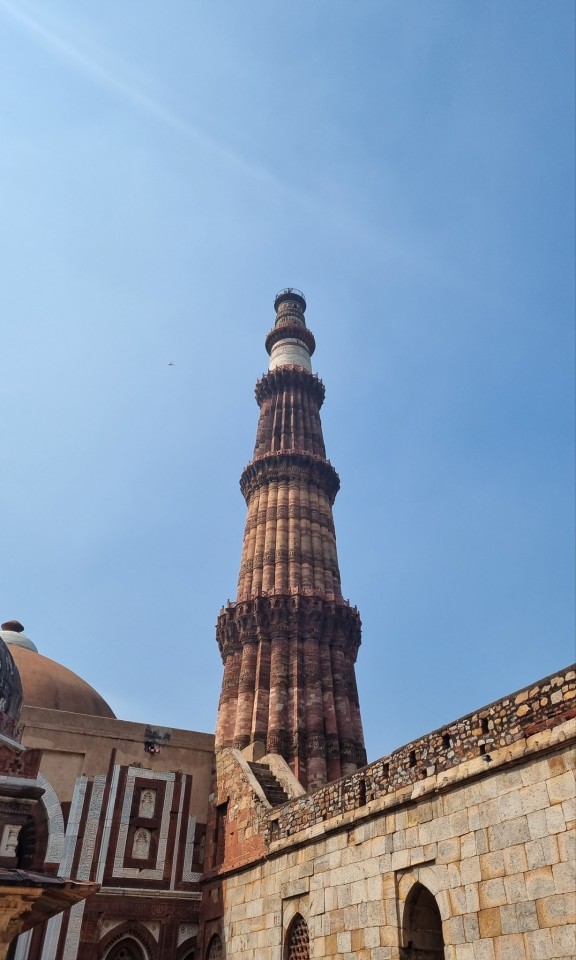
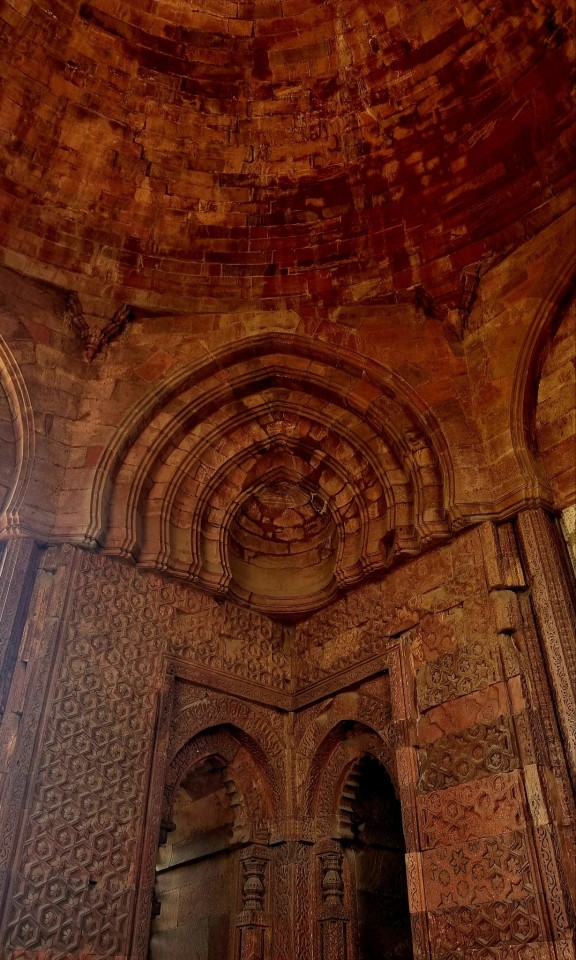
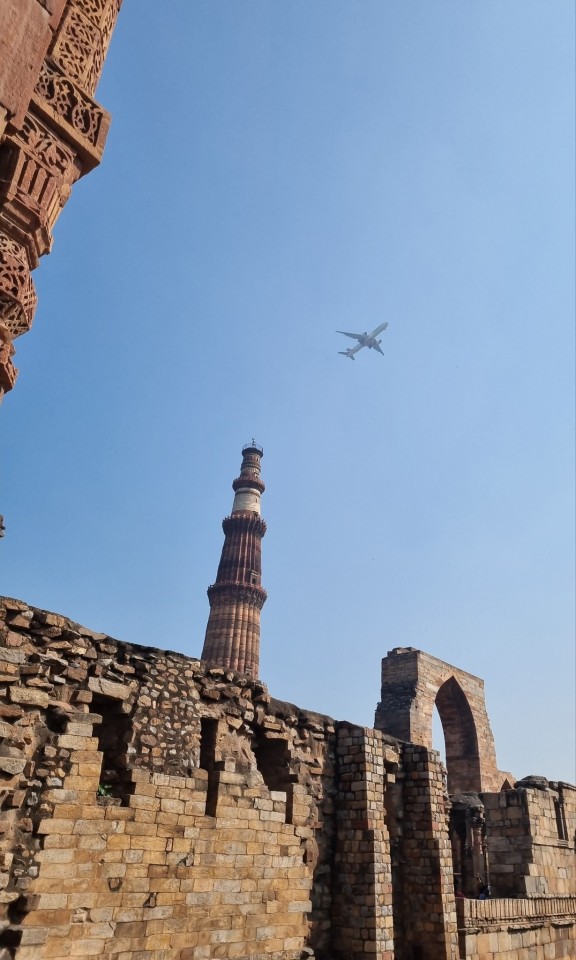
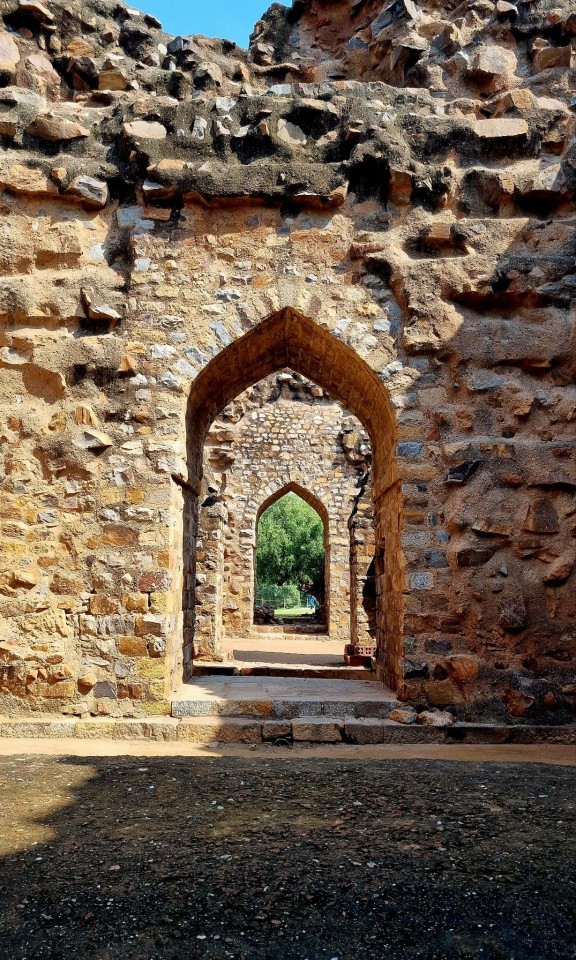
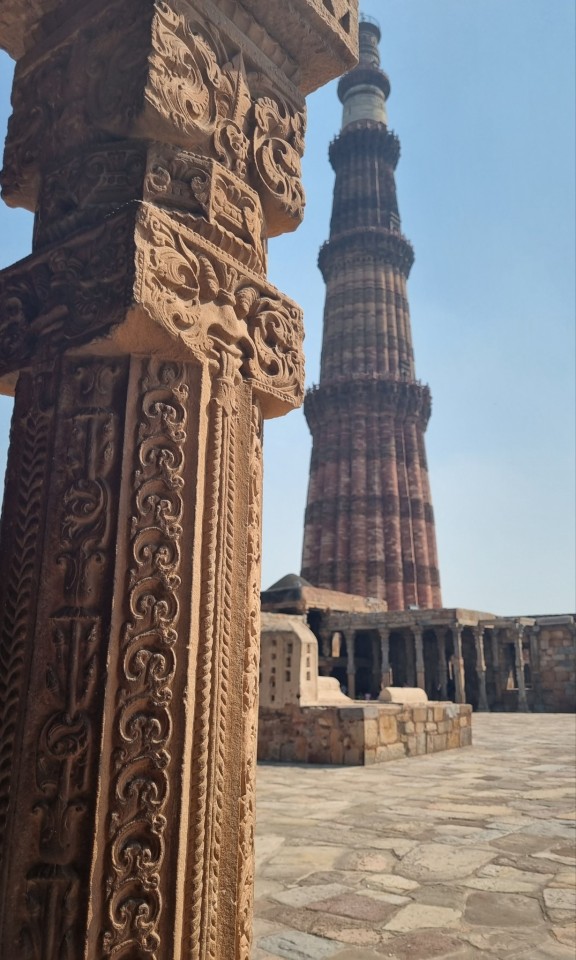


Please like or repost if downloading. Please give credit if you're sharing it online.
#qutub minar#history#monuments#dilli#delhi#new delhi#india#cultural#asia#delhi sultanate#mughals#mehrauli#qutub complex#indo islamic architecture#qutb ud din aibak#iltutmish#tughlaq dynasty#lodi dynasty#wallpaper#historical wallpapers#phone wallpapers#indian monuments#historical monuments#for you#trending#tumblr
8 notes
·
View notes
Photo
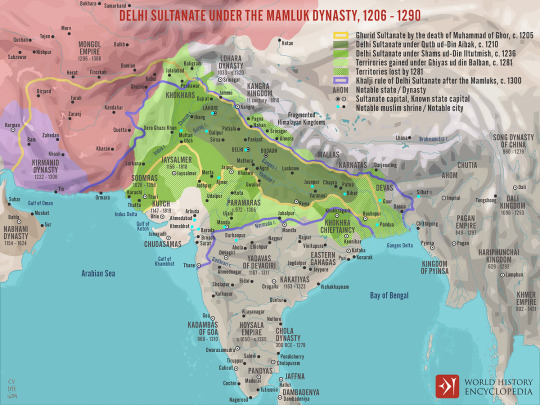
Delhi Sultanate under the Mamluk Dynasty, 1206-1290
A map illustrating the rise and evolution of the Sultanate of Delhi during the times of its first ruling dynasty – the Mamluks (also known as the Slave or Ghulam Dynasty), an influential military class of slave soldiers between 1206 and 1290. Following the assassination of the childless Muhammad bin Sam, popularly known as Muhammad of Ghor, in 1206, the Ghurid Sultanate shattered into minor kingdoms ruled by Mamluk commanders. The appointed governor of the Indian territories, Qutb ud-Din Aibak, a Turkic slave general, became the ruler of what was to become the Sultanate of Delhi. Through its turbulent history (until 1526, when the invasion of Babur swept it aside, the Sultanate was ruled by five unrelated dynasties), multiple autonomous states challenged the influence and control of the Delhi Sultanate in the fertile lands between the rivers Ganga and Jamuna, which was reflected in its ebbing and ever-changing frontiers.
Image by Simeon Netchev
39 notes
·
View notes
Photo
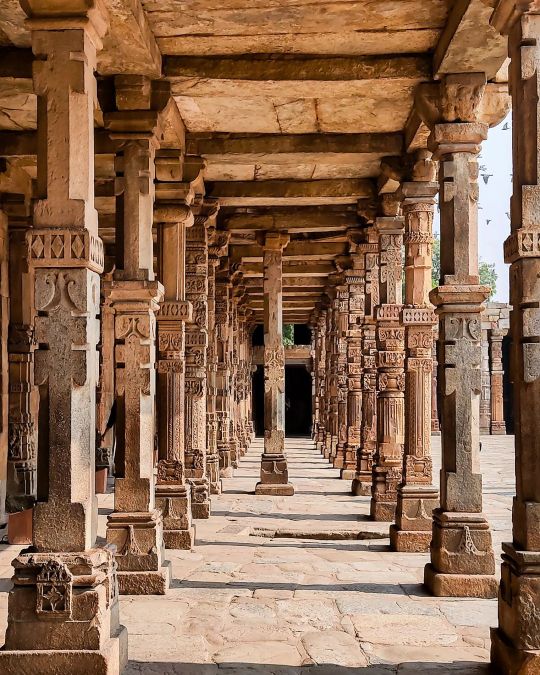
Carved pillar passage Qutub Complex The Indian Slave Dynasty (Mamluk Dynasty) lasted from 1206 to 1290, almost a century. The list of sultans is as follows Qutb ud-Din Aibak (1206 – 1210 AD) Aram shah (1210 – 1211 AD) Iltutmish (1211 – 1236 AD) Rukn-ud-din-Firoz (1236 AD) Razia al-Din (1236 – 1240 AD) Muiz-ud-din Bahram (1240 – 1242 AD) Ala-ud-din Masud (1242 – 1246 AD) Nasir-ud-din Mahmud (1246 – 1266 AD) Ghiyas-ud-din Balban (1266 – 1285 AD) Muiz-ud-din Muhammad Qaiqabad (1286 – 1290 AD) #qutubminar #delhi #worldheritagesite #history #carving #stonestructures #stonecarving #historyofindia #slavedynasty #lalkot #qutubcomplex #window #ancientmarvels #india #phonephotography #photography #mumbai #maharashtra #redsandstone #marble #delhidiaries #quwwatulislammosque # (at Qutub Minar) https://www.instagram.com/p/Cl2wjWHykQV/?igshid=NGJjMDIxMWI=
#qutubminar#delhi#worldheritagesite#history#carving#stonestructures#stonecarving#historyofindia#slavedynasty#lalkot#qutubcomplex#window#ancientmarvels#india#phonephotography#photography#mumbai#maharashtra#redsandstone#marble#delhidiaries#quwwatulislammosque
3 notes
·
View notes
Text
Urdu isnt hindi, urdu is older and hindi formed out of urdu
Urdu origin is without a doubt within the military camps of Mahmud of Ghazni. This is not up for discussion. Its literally in the name. Urdu meaning "camp" in Turkic languages. This is also referenced in "Alberuni's India", translated by German Orientalist E. C. Sachau, vol.ii, p.253-258 which clearly states that the origin of Urdu was in the Ghaznavid camps.
Mahmud, a Persianised Turkic Sultan who founded the Ghaznavid empire led a mixed Persian-Turkic army which was mainly Dari (Persian) speaking.
Mahmud attacked and captured Punjab around year 1000 AD (then referred to as Lahore and Multan in sources). This would be the only region that he annexed. All other regions that he attacked were plundered and left in the hands of Hindu and Buddhist vassals. He settled his army of occupation in Lahore.
Mahmud`s descendants held the Punjab for almost 200 years before they were attacked from their east by Muhammad Ghori who had already sacked Ghazni and it wasnt until year 1193 AD that Ghoris chief general, Qutb-ud-Din Aibak took Delhi.
Let that sink in. Mahmud of Ghazni never occupied Delhi. But Urdu emerged from Ghaznavids camps over a two hundred year period that his forces occupied Punjab. Then under what pretense could anyone claim that Urdu emerged in Ganga?
However, this is not to say that Delhi did not have an influence on Urdu. We are not shameless insecure liars so lets continue this history lesson. Like any language Urdu evolved with time. Ghaznavids forces were merged with Ghoris forces because he simply didn't trust leaving his former enemy army behind as he took on Delhi. The combined army occupied Delhi and introduced early Urdu to modern day India. But just as in Punjab, the forces encountered a local dialect called Khari Boli. This would influence Urdu and Mughals would introduce more dialects so the idea that Delhi influenced Urdu is certainly true. But the origin of Urdu is without a doubt the Ghaznavid Military camps before Lahore or Delhi come into the picture.
Throughout this timeline Urdu was referred to as Hindustani, Hindvi, Zaban-e-Urdu, Zaban-e Urdu-e Mualla etc.
Modern Hindi was derived from Urdu in the 19th century, so that misnomer has no effect on the history of Urdu.
Hope that clears up any confusion you might have had.

#urdu aesthetic#urdu stuff#hindi news#india#hindi#pakistan#pakistani#history#ancient history#Pakistani history
2 notes
·
View notes
Text
It’s a victory tower commissioned by Qutb-ud-din Aibak in 1192 but he was not able to build more than the first floor but in 1220 his successor Shams-ud-din Iltutmish added three more floors. According to the story it got damaged by lightning in 1369 and then it was reconstructed by Firoz Shah Tughlaq and he was the one who gave Qutub minar its fifth floor.
0 notes
Text
The 8 Beautiful Places to Visit in the Golden Triangle
The Golden Triangle Tour in India is a captivating journey spanning Delhi, Agra, and Jaipur, forming a triangle on the map. Each destination is steeped in rich history, cultural splendor, and architectural marvels. From the bustling streets of Delhi to the iconic Taj Mahal in Agra, and the majestic forts of Jaipur, this tour offers an immersive experience into India's diverse heritage and vibrant traditions. Discover the Mughal grandeur, Rajputana opulence, and modern Indian life, all in one exhilarating expedition.
Here are eight beautiful places you must visit while exploring the Golden Triangle:
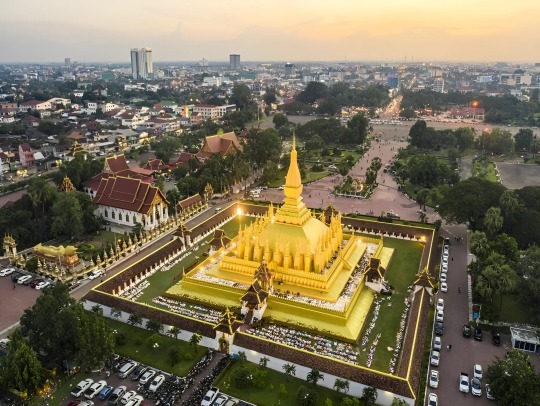
1. Taj Mahal, Agra:
One of the most iconic landmarks in the world, the Taj Mahal is a white marble mausoleum built by Mughal Emperor Shah Jahan in memory of his wife Mumtaz Mahal. Its beauty is unmatched, especially during sunrise and sunset.
Also Read: Kazakhstan tour package
2. Agra Fort, Agra:
A UNESCO World Heritage Site, Agra Fort is a massive red sandstone fort built by Emperor Akbar in the 16th century. It offers panoramic views of the Taj Mahal and houses several palaces, mosques, and gardens.
Also Read: Armenia tour package
3. Amber Fort, Jaipur:
Also known as Amer Fort, this majestic fort is located in Jaipur, Rajasthan. Built with red sandstone and marble, it overlooks Maota Lake and features stunning architecture, including the Sheesh Mahal (Mirror Palace).
Also Read: Georgia package
4. Hawa Mahal, Jaipur:
Translating to "Palace of Winds," Hawa Mahal is a unique five-story palace with a façade adorned with intricate latticework. Built in 1799 by Maharaja Sawai Pratap Singh, it allowed royal ladies to observe street festivals without being seen.
Also Read: Maldives tour package
5. City Palace, Jaipur:
This grand palace complex in the heart of Jaipur showcases a blend of Rajasthani and Mughal architectural styles. It houses museums, courtyards, gardens, and the Chandra Mahal and Mubarak Mahal.
Also Read: Sri Lanka tour
6. Qutub Minar, Delhi:
The tallest brick minaret in the world, Qutub Minar is a UNESCO World Heritage Site located in Delhi. Built in the 12th century by Qutb-ud-din Aibak, it is surrounded by several historically significant monuments.
Also Read: Hongkong tour
7. Humayun's Tomb, Delhi:
Another UNESCO World Heritage Site, Humayun's Tomb is the tomb of the Mughal Emperor Humayun. Built-in the 16th century, it is known for its Persian-inspired architecture and lush gardens.
Also Read: Hyderabad trip
8. Lotus Temple, Delhi:
Shaped like a lotus flower, this Bahá'í House of Worship is one of Delhi's most recognizable landmarks. It welcomes people of all religions to pray or meditate in its serene surroundings.
Also Read: Europe tour package
Conclusion
Embark on a mesmerizing journey through India's Golden Triangle tour, discovering its 8 breathtaking gems. From the majestic Taj Mahal to the vibrant streets of Jaipur, each destination enchants with its rich history and cultural splendor. Explore, immerse, and let the Golden Triangle weave unforgettable memories of beauty and wonder.
0 notes
Text


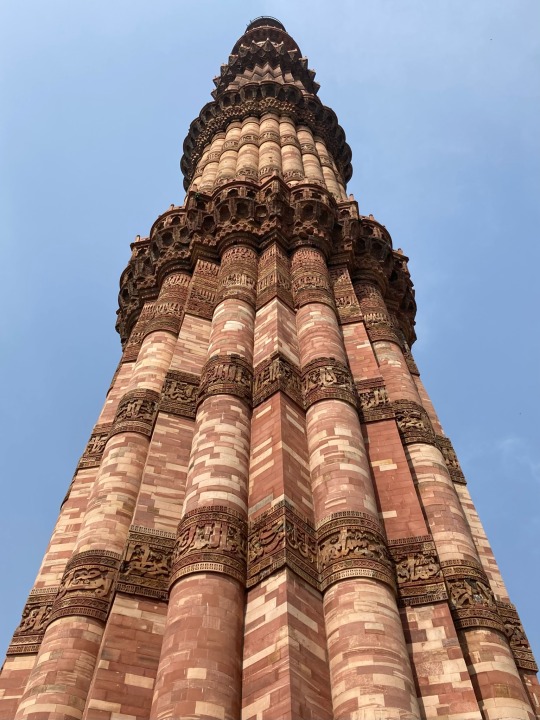
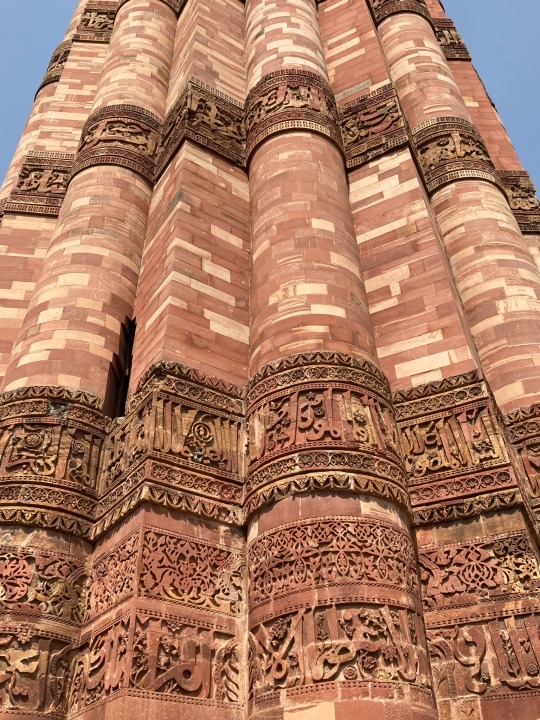

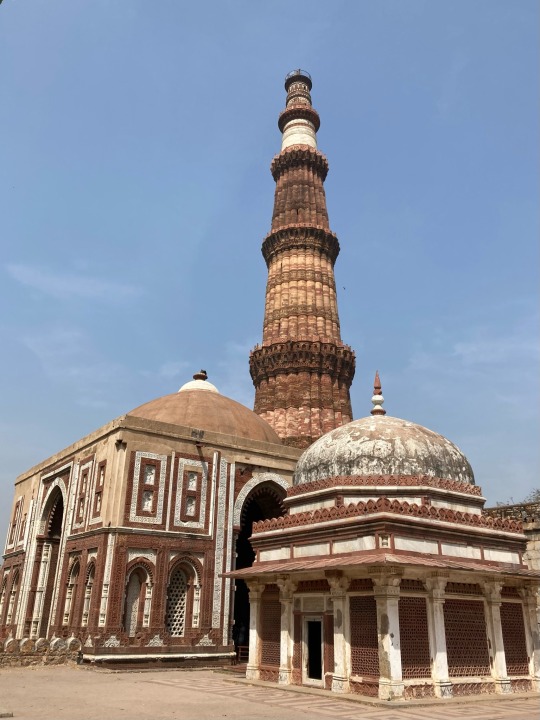

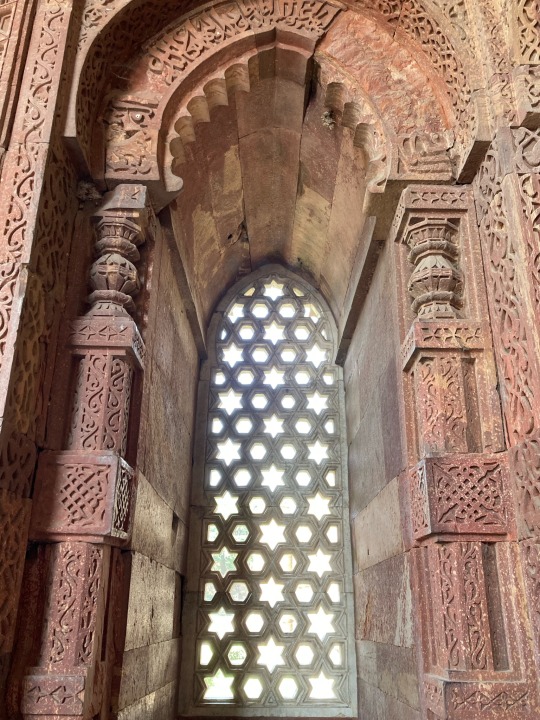


Next stop was the Qutab Minar. The Qutab Minar is a minaret and was part of north India’s first mosque.
The minaret is 238 foot (72.5 metres) tall, and the photographs cannot really show you how high it is.
Construction started in 1199 by Qutb ud-Din Aibak and was completed around 1220 by his son-in-law Iltutmish. The last photograph shows the base for another minaret which was due to be twice the size!
0 notes
Text

Qutub minar is standing tall in the heart of Delhi. It is constructed in the early 13th century by Qutb-ud-din Aibak. Qutub minar's architecture is a masterpiece of indo islamic design.
To know each and every details about qutub minar visit tookmehere
0 notes
Text
Places to Visit in North india
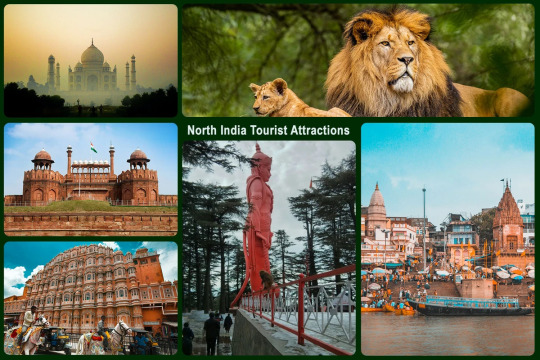
North India is a beautiful region with a wealth of attractions that can be explored on a trip. From cosmopolitan cities like Delhi and Mumbai to charming villages and stunning beaches, here are five of the best places to visit in North India.
1. Delhi
Delhi is one of the most densely populated cities in the world, with a population of more than 20 million people. Nevertheless, it's easy to get around, and there are many places to explore if you have a few hours to spare.
Some of the most popular attractions in Delhi include the Qutub Minar, the Red Fort, India Gate, and Raj Ghat. The Qutub Minar is one of the most iconic landmarks in Delhi and was built by Qutb-ud-din Aibak in 1206. The Red Fort was once the residence of Mughal emperors and is now a UNESCO World Heritage Site. India Gate was constructed in 1857 as a monument to commemorate British victory over Indian forces in the first Anglo-Indian War. Raj Ghat is a sacred Hindu site where pilgrims perform cremation ceremonies.
2 .Agra
If you're visiting India and want to experience some of the country's most beautiful architecture, head to Agra. The city is home to some of the most iconic monuments in India, such as the Taj Mahal, and it's easy to see why. There's always something new to see here, and it's a great place to explore if you have plenty of time. Additionally, Agra is a great place to eat. The local cuisine is mouth-watering and there are plenty of restaurants where you can try different dishes.

3. Jaipur
Jaipur is the pink city of North India. The Pink City is a prosperous city that is home to many attractions and places of interest. Jaipur has a rich cultural heritage and is known for its lavish palaces, forts, gardens, and temples. It is also known for its traditional crafts and handloom industries. Jaipur is a great place to visit if you want to experience the traditional lifestyle of Indian aristocracy.
4. Udaipur
Udaipur is a city in Rajasthan, India, on the banks of the River Mandovi. It is often called the "Paris of India" for its elegant architecture and vast boulevards. The city was founded in 1569 by Maharana Udai Singh II, who ruled until his death in 1598. Udaipur remains an important trade center and tourist destination, especially during the monsoon season when it is flooded with tourists.
5. Varanasi
If you're looking to get off the beaten path and explore some of North India's less-known gems, Varanasi is the perfect place to start. With a history that dates back over 2,500 years, this ancient city is full of fascinating sights and sounds. From the hustle and bustle of the main thoroughfare to the quieter back streets, there's sure to be something here for everyone. And if you're looking for an atmosphere that's both spiritual and vibrant, Varanasi is definitely worth a visit.
Rishikesh
Rishikesh, also known as the spiritual capital of India, is a must-see destination for travelers looking to discover some of the most beautiful landscapes in the country. Situated atop the banks of the Ganges River, Rishikesh is a popular spot for yoga and meditation retreats and offers visitors a chance to experience some of Hinduism's holiest sites. If you're looking to explore more of northern India, be sure to add Rishikesh to your itinerary. Here are some other places you should visit while in Rishikesh:
The Yamunotri Temple : This temple is dedicated to Yamuna, the goddess of water who is believed to have blessed Rishikesh with her presence. The temple features beautiful murals and an impressive statue of the goddess.
: This temple is dedicated to Yamuna, the goddess of water who is believed to have blessed Rishikesh with her presence. The temple features beautiful murals and an impressive statue of the goddess. The Jyotirlinga Temple : This Hindu temple is home to one of India's most important lingas (holy stones). The temple is said to possess miraculous powers and pilgrims are often seen offering prayers here

Delhi
If you're looking for a city that oozes history and culture, Delhi is the place for you. The hustle and bustle of the city can be overwhelming, but it's worth it to take in some of India's most iconic landmarks. Start your visit with a wander through Old Delhi, where narrow alleyways lead to centuries-old buildings decorated with intricate patterns of brick and marble. Then head to the New Delhi district, home to the country's presidential palace and other monumental government buildings. If you've got time to kill, make a pilgrimage to the Taj Mahal, one of the world's most famous structures. And if all that sounds too touristy, head out to the rural areas of Northern India for some traditional villages and stunning landscapes.
Nalanda
Nalanda was a great university that reached its peak in the 9th century AD. The ruins of the university are a UNESCO World Heritage Site. Other places to visit in North India include Rishikesh, Varanasi, and Haridwar.
Shimla
Shimla is considered to be the queen of hill stations in North India. The beauty of Shimla can be simply breathtaking. It is a must-visit destination for anyone who loves nature and wants to experience the best of what India has to offer. Shimla is also home to some of the most popular tourist spots in the area, including the Palace of Woodlands and Chandigarh Royal Palace.
If you're looking for places to relax and explore, Shimla has plenty to offer. From lakeside walks to horseback rides, there's something for everyone here. And if you're feeling energetic, there's plenty to do outdoors as well - hiking, biking, skiing and snowboarding are all possible in this beautiful area.
Manali
If you're looking for a destination that is both peaceful and captivating, consider heading to Manali in North India. This charming city is located in the Himachal Pradesh region and features an incredible mountainous backdrop. From here, you can explore some of the most popular tourist destinations in the area, such as Agharkot and Leh. Additionally, Manali is a great place to spend a winter holiday, as the temperatures are comfortable year-round. If hiking is your thing, be sure to check out Rohtang Pass – one of the most challenging trails in India.

Conclusion
If you are looking for a place to explore North India, there is no shortage of options. From ancient cities like Jaipur and Udaipur to lush green landscapes like the Himalayas, there is plenty to see and do in this part of the world.
From the ancient city of Agra to the hill stations of Shimla and Manali, there is much to see and enjoy in this region of India. And if you're planning on visiting any of these destinations during the winter season, make sure to pack your warm clothes — it can get chilly up in those hills!
So why not take a look at our list of places to visit in North India and get started planning your trip today?
0 notes
Text
Qutub Minar: Unveiling the Majesty of Delhi's Timeless Icon
The panoramic expanse of Delhi, the capital city of India, is interspersed with architectural marvels that epitomize its rich historical tapestry. Among these landmarks, Qutub Minar stands tall as an iconic monument that embodies the grandeur, resilience, and cultural synthesis that define the heritage of Delhi. This UNESCO World Heritage Site, steeped in centuries of history and architectural magnificence, beckons travelers and enthusiasts of art and culture to embark on a captivating voyage through time. In this essay, we embark on an enlightening odyssey to unravel the enigmatic allure and profound aegis of Qutub Minar, delving into its historical significance, architectural nuances, and the enduring legacy that endears it to connoisseurs of heritage and heritage alike.
A Chronicle of History: Unveiling the Temporal Reverence
Qutub Minar, an exemplar of Indo-Islamic architecture, stands as a resplendent testament to the triumphs, tribulations, and transitions that have shaped the historical trajectory of Delhi. Its origins, rooted in the 12th century during the reign of the Delhi Sultanate, resonate with the resonant echoes of dynastic legacies, cultural confluences, and the resplendence of Mughal craftsmanship. The monument, originally conceptualized as a commemorative insignia of Islamic victory and cultural assimilation, has evolved over the centuries to embody the transformative epochs of Delhi's history, mirroring the ascendancy of empires and the transitions of architectural paradigms. Qutub Minar, with its venerable bears, soaring height, and ornate embellishments, serves as a veritable epitome of the city's historical continuum, entwining the strands of bygone eras into a resplendent showcase of temporal reverence.
Architectural Splendor: A Monolith of Artistry and Formidable Grandeur
The architectural edifice of Qutub Minar stands as a towering marvel of artistry, engineering finesse, and cultural amalgamation that captivates visitors with its resplendent form and intricate detailing. The monument, constructed predominantly of red sandstone intermingled with marble, reflects the fusion of Persian, Indian, and Islamic architectural influences, yielding a seamless synthesis of diverse artistic traditions. The resplendent facade of Qutub Minar, adorned with intricate floral motifs, calligraphic inscriptions, and geometric patterns, bears testimony to the consummate craftsmanship and attention to detail that endow the monument with an aura of timeless magnificence. The minar, soaring to a height of approximately 73 meters, is sheathed in a spiral staircase with 379 steps, enabling visitors to ascend its hallowed ramparts and partake in the panoramic vistas that stretch across the historical landscape of Delhi.
The complex of Qutub Minar, embellished with verdant gardens, iconic edifices such as the Quwwat-ul-Islam Mosque, the Alai Darwaza, and the Iron Pillar of Delhi, exemplifies the valor of Mughal architecture, enshrining within its confines a quintessential ensemble that narrates the saga of confluence, conquest, and cultural transcendence. The architectural melange encompasses ornate calligraphy, filigree carvings, and decorative elements that embody the artistic paradigms of the Mughal epoch, transmuting the complex into an immersive tapestry of aesthetic, spiritual, and historical eloquence.
Historical Significance: An Odyssey Through Dynastic Legacies
The historical significance of Qutub Minar resounds with the chime of dynastic legacies, architectural ascendancy, and the transformative vicissitudes that have defined the course of Delhi's history. Commissioned by Qutb-ud-Din Aibak, the founder of the Delhi Sultanate and the first Islamic ruler of Delhi, the construction of the minar was emblematic of his triumph over the Hindu Rajput dynasty, signifying the advent of Islamic dominion in Northern India. The subsequent expansions and embellishments carried out by subsequent rulers, such as Iltutmish and Firoz Shah Tughlaq, served to embellish the complex with architectural opulence and cultural resonance, imprinting upon it the imprimatur of successive dynastic legacies. As such, Qutub Minar stands not merely as a monumental colossus but as a living testament to the temporal continuum of Delhi's dynastic transitions, architectural finesse, and cultural confluences that have shaped its identity.
Cultural Extrapolation: A Symbol of Syncretism and Artistic Eminence
Qutub Minar, beyond its architectural grandeur and historical significance, serves as an emblem of cultural syncretism, artistic eminence, and spiritual symbolism that permeates the collective ethos of Delhi. The intricate calligraphy adorning the monument enunciates passages from the Quran, infusing the edifice with profundity of religious and intellectual reverence. Its proximity to the Quwwat-ul-Islam Mosque, an erstwhile Hindu temple repurposed into a grand mosque, imparts a poignant testimony to the synthesis of diverse religious motifs and architectural heritages, yielding an edifice that resonates with the harmonic convergence of cultural diversity and spiritual sagacity. The towering edifice of Qutub Minar, with its inherent connotation as a symbol of Islamic victory, transmutes into an emblem of cultural assimilation, artistic refinement, and the enduring legacy of syncretic harmonies that permeate the historical milieu of Delhi.
Contemporary Reverberations: A Conduit of Artistic Inspiration and Historical Enrichment
Qutub Minar, imbued with centuries of historical resonance and architectural grandeur, serves as a perennial source of artistic inspiration, historical enrichment, and contemplative introspection for visitors and scholars alike. The monument's enduring presence transcends its historical provenance, resonating with contemporary artists, architects, and historians as an exemplar of architectural finesse, cultural resonance, and the timeless allure of Delhi's historical heritage. Visitors, drawn to the monument from across the globe, are enraptured by the palpable sense of antiquity, cultural confluence, and architectural opulence woven into the fabric of Qutub Minar, wherein each hallowed edifice becomes a testament to the enduring legacy of Delhi's historical continuum.
Preservation and Recognition: Safeguarding a Monumental Legacy
The conservation and safeguarding of Qutub Minar stand as imperatives that seek to uphold its monumental legacy, historical resonance, and architectural splendor for posterity. Various initiatives undertaken by governmental and non-governmental organizations have endeavored to preserve the structural integrity, aesthetic opulence, and historical significance of the Qutub Minar complex, thereby fostering a continuum of cultural stewardship and heritage valorization. The monument's inscription as a UNESCO World Heritage Site underscores its global significance, impelling the collective efforts of conservationists, historians, and stakeholders to ensure the perpetual safeguarding of its illustrious heritage.
Epilogue: Embracing the Temporal Tapestry of Qutub Minar
In summation, Qutub Minar ensconces within its towering embrace the multitudinous facets of historical reverberation, architectural grandeur, cultural syncretism, and the timeless allure that endears it to the echelons of timeless architectural marvels. From its inception as a symbol of Islamic ascendancy to its contemporary resonance as a beacon of historical enrichment and cultural atemporality, Qutub Minar embodies the veritable essence of Delhi's historical tapestry. The monument's architectural finesse, temporal resonance, and cultural amalgamation emanate a transcendent allure, inviting travelers, scholars, and enthusiasts on an enlightening odyssey that unravels the enigmatic vistas of bygone epochs and artistic refinement. Qutub Minar, with its towering edifice, intricate detailing, and historical provenance, stands as a testament to the enduring majesty of Delhi's architectural heritage, enfolding within its precincts the resplendent echoes of temporal splendor and cultural convergence.
If you are live in jodhpur and you want to visit Delhi then, let me recommend you the best taxi service in jodhpur named as jodhpur cab service. Jodhpur Cab Service provides there customer best services by their chauffeur.
0 notes
Text
Delhi taxi service in jaipur with Dream Cab Service

Distance From Jaipur To Delhi By Car
The driving distance between Jaipur and Delhi is approximately 275 km. And driving is one of the best road trips you can take. Cab travel from Jaipur to Delhi is a wonderful and exciting experience.
Time From Jaipur To Delhi By Car
Depending on traffic, it takes a car about 4 hours and 50 minutes to go from Jaipur to Delhi. Please allow for traffic, adding 30 to 60 minutes.Jaipur Cab Service offers the most dependable taxi service in India when you book a taxi from Jaipur to Delhi.
Jaisalmer is located 575 kilometres (357 mi) west of the state capital Jaipur.
Planning a trip from Jaipur to Delhi? If yes, then Dream Cab Service can help you plan for a safe and convenient journey. We will provide you with information on Jaipur to Delhi taxi services, so that you can make your journey smoothly and safely.
Travelling From Jaipur To Delhi: Fun And Unique
Travelling from Jaipur to Delhi is full of many exciting and unique experiences. This journey takes you from the rich heritage of Rajasthan toJaipur to Delhi Cab fare the urban life of Delhi. You will find natural beauty and many interesting stories of history along the streets.
Major Tourist Places Of Delhi
Delhi, the capital of India, is a city rich in historical and cultural heritage which is a land of diversity. Here are some of the major tourist places that will surely tug at your heartstrings:
Qutub Minar: This World Heritage Site is the pride of Delhi, which has been recognized as a UNESCO World Heritage Site. This life-prisoner was built by Qutb-ud-din Aibak, the Sultan of Delhi, and is 73 metres tall.
Humayun's Tomb: It is a magnificent Mughal structured monument, which was built in the name of Humayun, the wife of Akbar. Its style and the beauty of the garden of the mausoleum are very famous.
Red Fort: It is an important site in Indian history which was built by the Mughal Emperor Shah Jahan. The specialty of its walls is their red colour.
India Gate: It was built to keep alive the memories of the Indian freedom struggle. It is a symbol of the valour of the Indian Army.
Raj Ghat: It is situated on the banks of river Yamuna and attracts tourists so that they can enjoy the beauty of the river.
Akshardham Temple: This temple is about to reveal the diversity of Indian culture and the attraction here is due to its unique peaks and craftsmanship.
#jaipur city tour#jaipur tour package#jaipur sightseeing tour#jaipur to delhi cab#taxi service#jaipur tourism#india
0 notes
Text
Discover the Top 10 Historical Places in Delhi: A Comprehensive Guide
Delhi, India's capital, is a city saturated with a rich tapestry of history and culture.From ancient empires to modern times, Delhi has been a witness to centuries of historical events, making it a treasure trove of historical sites. In this comprehensive guide, we will take you on a journey through the top 10 historical places in Delhi that showcase the city's rich and diverse heritage. Whether you're a history enthusiast or a traveler looking to explore the past, these sites offer a fascinating glimpse into India's history.
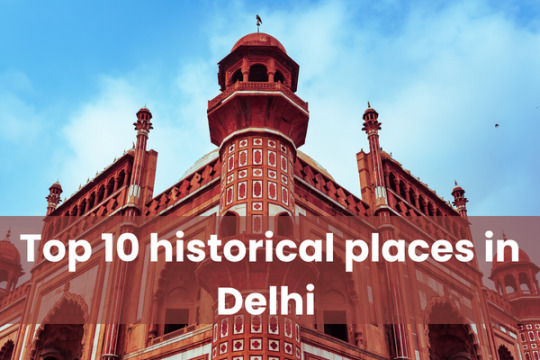
1. Red Fort
The Red Fort, also known as Lal Qila, is one of Delhi's most iconic historical landmarks. Commissioned by Emperor Shah Jahan during the 17th century, it functioned as the primary abode for the Mughal emperors. The fort's stunning red sandstone architecture and intricate design, including the Diwan-i-Aam and Diwan-i-Khas, make it a UNESCO World Heritage Site. A visit to the Red Fort is a step back in time to the grandeur of the Mughal era.
2. Qutub Minar
Qutub Minar is another UNESCO World Heritage Site and a symbol of Delhi's ancient history. This 73-meter-high minaret was built in the 12th century by Qutb-ud-din Aibak. The complex also includes the Quwwat-ul-Islam Mosque, which is one of the earliest mosques in India. The intricate carvings and the impressive height of the Qutub Minar make it a must-visit historical site.
3. Humayun's Tomb
Humayun's Tomb, a majestic Mughal mausoleum, is a testament to the exquisite Mughal architecture. Built in the mid-16th century, it predates the Taj Mahal and is often considered a precursor to it. The beautifully landscaped gardens and the tomb's symmetrical design are its defining features. It is also a UNESCO World Heritage Site and a place of serenity and historical significance.
4. India Gate
India Gate is a war memorial and an iconic symbol of Delhi. It was built in honor of the soldiers who sacrificed their lives during World War I. The Amar Jawan Jyoti, an eternal flame, is situated under the arch and represents the sacrifices made by the Indian Armed Forces. The lush green lawns around India Gate make it a popular spot for picnics and evening walks.
5. Jama Masjid
Jama Masjid is one of the largest mosques in India and an architectural masterpiece of the Mughal era. Commissioned by Shah Jahan, the mosque can accommodate over 25,000 worshippers. Its red sandstone and white marble construction, along with the stunning views from its minarets, create an awe-inspiring atmosphere. Visitors can also explore the bustling markets of Old Delhi surrounding the mosque.
6. Lotus Temple
The Lotus Temple is a modern architectural marvel and a symbol of religious harmony. Shaped like a lotus flower, it is a Bahá'í House of Worship where people of all faiths are welcome to meditate and pray. The structure is made of white marble and is surrounded by lush gardens, creating a serene and contemplative environment.
7. Akshardham Temple
Swaminarayan Akshardham Temple is a sprawling complex dedicated to spirituality and art. It houses the Akshardham Mandir, a magnificent temple with intricate carvings, and the Yagnapurush Kund, the world's largest stepwell. The temple also features exhibitions and light and sound shows that narrate India's rich cultural and spiritual heritage.
8. National Museum
The National Museum in Delhi is a treasure trove of historical artifacts, art, and sculptures. It showcases India's rich cultural heritage through its extensive collection. From ancient archaeological finds to medieval and modern art, the museum provides a comprehensive view of India's history and artistic evolution.
9. Tughlaqabad Fort
Tughlaqabad Fort, built by Ghiyas-ud-din Tughlaq in the 14th century, is a massive fortress that reflects the architectural prowess of the Tughlaq dynasty. The fort's ruins are a striking sight, with its imposing walls and the tomb of Ghiyas-ud-din Tughlaq. Exploring this fort is like stepping into a different era of Delhi's history.
10. Raj Ghat
Raj Ghat is a simple yet profound memorial to Mahatma Gandhi, the father of the nation. It is a black marble platform marking the spot of his cremation in 1948. Surrounded by beautifully maintained gardens, Raj Ghat is a place of reflection and homage to the great leader who played a pivotal role in India's struggle for independence.
Conclusion
Delhi's historical sites are not just monuments; they are windows into India's rich and diverse history. From the grandeur of the Mughal era to the architectural marvels of modern times, the top 10 historical places in Delhi offer a captivating journey through the ages. Whether you're interested in architecture, art, spirituality, or simply exploring the past, Delhi's historical treasures have something to offer every visitor. So, plan your trip to Delhi and immerse yourself in the city's remarkable heritage.
1 note
·
View note
Text
Qila Rai Pithora, Delhi: A Historical Tapestry of an Ancient Fort
Qila Rai Pithora, often referred to as the first city of Delhi, stands as an ancient testament to the city's rich and diverse history. Located in the heart of India's capital, this fort carries within its walls a storied past that reflects the rise and fall of empires and the evolution of an era. In this article, we will journey back in time to explore the historical tapestry of Qila Rai Pithora and its enduring significance.
Origins and Naming
Qila Rai Pithora owes its origins to the reign of Prithviraj Chauhan, a powerful Rajput king of the Chahamana dynasty. He established this fort in the 12th century, making it a strategic stronghold for his kingdom. It was initially named "Lal Kot" or the Red Fort due to the extensive use of red sandstone in its construction. Later, the fort was further fortified and expanded by subsequent rulers.
Architectural Marvels
The architectural marvels of Qila Rai Pithora showcased a blend of Hindu and Islamic influences. The fort was fortified by massive walls and gates, with intricate carvings and designs adorning the structures. The fortifications were a testimony to the engineering prowess of that era.
Within the fort, there were palaces, temples, residential areas, and public buildings, each showcasing the opulence and grandeur of the time. The Qila Rai Pithora complex also housed a stunning victory tower known as the Qutub Minar, which was commissioned by Qutb-ud-din Aibak, one of the early rulers of the Slave Dynasty.
The Rise and Fall
The fort of Qila Rai Pithora witnessed the highs and lows of medieval Indian history. Prithviraj Chauhan's reign was marked by prosperity and stability, but it eventually faced challenges from the ambitious Muhammad Ghori, leading to the infamous battles of Tarain. Following Prithviraj Chauhan's defeat, the fort came under the rule of the Delhi Sultanate and various other dynasties.
Over time, Qila Rai Pithora fell into decline due to subsequent invasions, sieges, and shifting power dynamics. It was later overshadowed by newer forts and cities built within Delhi, eventually leading to its abandonment and subsequent ruin.
Present and Preservation
Today, what remains of Qila Rai Pithora are the ruins and remnants of its former glory. The site is recognized as a significant archaeological heritage and is protected by the Archaeological Survey of India (ASI). Visitors can explore the ruins, witness the surviving architectural elements, and imagine the grandeur of the past.
Despite the ravages of time, Qila Rai Pithora holds a unique historical and architectural value. Its existence is a reminder of the rich tapestry of Delhi's history, showcasing the ever-changing dynasties and influences that shaped the region over centuries.
Conclusion
Qila Rai Pithora, the first city of Delhi, remains a fascinating historical site, offering a glimpse into India's medieval past. As we walk through its ruins, we can imagine the grandeur and splendor that once graced this ancient fort, appreciating the architectural prowess and rich history that continue to captivate the imagination of historians and visitors alike.
0 notes
Text
Qutub Minar and its monuments
Context: The initial stage of restoration efforts for the Alai Darwaza (at Qutub Minar complex) will be undertaken by the Archaeological Survey of India.
Alai Darwaza
Originally, Qutb-ud-din Aibak commissioned the construction of a mosque, later partly expanded by Shamsuddin Altamash (Iltutmish).
Alauddin Khilji had grand plans for the Qutub complex, aiming to enlarge the Quwwat-ul-Islam…

View On WordPress
1 note
·
View note
Text
Discovering Delhi's Historic Heritage: Exploring the Iconic Monuments
Introduction:
Delhi, the vibrant capital city of India, is not only a bustling metropolis but also a treasure trove of historical wonders. Steeped in a rich tapestry of cultures and civilizations, Delhi’s iconic monuments stand tall as testament to the city’s glorious past. From majestic Mughal architecture to ancient ruins, Delhi offers a fascinating journey back in time, attracting history enthusiasts and tourists alike. In this article, we embark on a captivating tour of some of Delhi’s most iconic monuments, delving into their historical significance and exploring the unique stories they tell.
Red Fort — A Symbol of Mughal Grandeur:
Our journey through Delhi’s historic heritage begins with the magnificent Red Fort (Lal Qila). Built by Emperor Shah Jahan in the 17th century, this imposing red sandstone fortress served as the residence of Mughal emperors for nearly two centuries. As a UNESCO World Heritage Site, the Red Fort exudes an aura of grandeur with its impressive architecture and intricate detailing. Visitors can explore its various halls, pavilions, and gardens, imagining the lavish ceremonies and royal gatherings that once graced its grounds.
Qutub Minar — A Tower of Triumph:
Next on our itinerary is the iconic Qutub Minar, an ancient marvel that dates back to the 12th century. Standing at a soaring height of 73 meters, this UNESCO-listed minaret is a striking example of Indo-Islamic architecture. Originally built by Qutb-ud-din Aibak and later expanded by subsequent rulers, the Qutub Minar serves as a symbol of victory and has survived the test of time despite numerous earthquakes and invasions.
Humayun’s Tomb — A Garden of Serenity:
Venturing further into Delhi’s heritage, we encounter Humayun’s Tomb, an architectural masterpiece that influenced the design of the Taj Mahal. Built in the mid-16th century for Emperor Humayun, this grand mausoleum is surrounded by well-manicured gardens and reflects the Persian-style charbagh layout. A blend of red sandstone and white marble, the tomb is an elegant testament to the Mughal dynasty’s artistic sensibilities.
Jama Masjid — Delhi’s Largest Mosque:
No exploration of Delhi’s historic heritage would be complete without visiting Jama Masjid, the largest mosque in the country. Commissioned by Emperor Shah Jahan, this majestic structure can accommodate thousands of devotees at once. With its three imposing domes, two towering minarets, and a vast courtyard, Jama Masjid stands as a symbol of religious harmony and architectural brilliance.
India Gate — A Memorial of Sacrifice:
Moving towards the heart of New Delhi, we encounter India Gate, a poignant war memorial honoring Indian soldiers who lost their lives during World War I. Designed by Sir Edwin Lutyens, this imposing arch stands as a solemn reminder of the sacrifices made by Indian soldiers and is illuminated every evening, providing a serene setting for visitors to pay their respects.
Conclusion:
Delhi’s historic heritage is a captivating saga of architectural brilliance, royal legacies, and the enduring spirit of India’s past. Exploring the iconic monuments of Delhi is akin to stepping into a time capsule that transports visitors to the grandeur of bygone eras. From the Red Fort’s imperial charm to the Qutub Minar’s triumphal presence, each monument weaves a unique tale of Delhi’s journey through history. Whether you are a history aficionado, a culture enthusiast, or a curious traveler, a visit to Delhi’s iconic monuments promises an unforgettable experience of the city’s captivating past.
0 notes
Photo

Qutub Minar, India
Architecture from the time when Sultans ruled the subcontinent. Built by Qutb ud-Din Aibak, who started construction in 1199.
1 note
·
View note